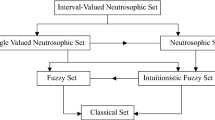Abstract
The neutrosophic sets are the prevailing frameworks that not only generalize the concept of fuzzy sets, but also analyse the connectivity of neutralities with different ideational spectra. In this article, we define a special type of neutrosophic set, named four-valued refined neutrosophic set (FVRNO), based on which various set-theoretic operators and properties of four-valued refined neutrosophic sets are studied. Often in many optimization problems of the real world, only the partial information about the values of parameters is available. In such situations, where impreciseness is involved in the information, classical techniques do not exhibit an appropriate optimal solution. A new concept to handle imprecise information is introduced and computational algorithm is formulated in four-valued refined neutrosophic environment. The new concept of optimization problem is an extension of intuitionistic fuzzy optimization as well as single-valued neutrosophic optimization. In this extended concept, indeterminacy is further refined as uncertain (U) and contradiction \((C= T\wedge F)\). Some examples to illustrate FVRNO are given and a comparative study of optimal solution between intuitionistic fuzzy optimization, single-valued neutrosophic optimization, multi-objective optimization using genetic algorithm, multi-objective goal attainment and four-valued refined neutrosophic optimization techniques were carried out and that concludes better optimal approximation is attained with new proposed optimization technique.


Similar content being viewed by others
References
Atansassov KT (1986) Intuitionistic fuzzy sets. Fuzzy Sets Syst 20(1):87–96
Bellman RE, Zadeh LA (1970) Decision-making in a fuzzy environment. Manag Sci 17(4):B-141
Bharati SK (2018a) Solving optimization problems under hesitant fuzzy environment. Life Cycle Reliab Saf Eng 7(3):127–136
Bharati SK (2018b) Hesitant fuzzy computational algorithm for multiobjective optimization problems. Int J Dyn Control:1–8
Bharati SK, Singh SR (2019) Solution of multiobjective linear programming problems in interval-valued intuitionistic fuzzy environment. Soft Comput 23(1):77–84
Campos L (1989) Fuzzy linear programming models to solve fuzzy matrix games. Fuzzy Sets Syst 32(3):275–289
Carlsson C, Korhonen P (1986) A parametric approach to fuzzy linear programming. Fuzzy Sets Syst 20(1):17–30
Chakrabortty S, Pal M, Nayak PK (2013) Intuitionistic fuzzy optimization technique for Pareto optimal solution of manufacturing inventory models with shortages. Eur J Oper Res 228(2):381–387
Chanas S (1983) The use of parametric programming in fuzzy linear programming. Fuzzy Sets Syst 11(1–3):229–241
Das P, Roy TK (2015) Multi-objective non-linear programming problem based on neutrosophic optimization technique and its application in riser design problem. Neutrosoph Sets Syst 9:88–95
Ghodousian A (2019) Optimization of linear problems subjected to the intersection of two fuzzy relational inequalities defined by Dubois-Prade family of t-norms. Inf Sci 503:291–306
Guu SM, Wu YK (2018) Multiple objective optimization for systems with addition-min fuzzy relational inequalities. Fuzzy Optim Decis Making:1–16
Jain H, Deb K (2013) An evolutionary many-objective optimization algorithm using reference-point based nondominated sorting approach, part II: handling constraints and extending to an adaptive approach. IEEE Trans Evol Comput 18(4):602–622
Kandasamy I, Smarandache F (2016) Triple refined indeterminate neutrosophic sets for personality classification. In: IEEE symposium series on computational intelligence (SSCI), pp 1–8
Luhandjula MK (1989) Fuzzy optimization: an appraisal. Fuzzy Sets Syst 30(3):257–282
Sahinidis NV (1983) Optimization under uncertainty: state-of-the-art and opportunities. Comput Chem Eng 28(6–7):971–983
Sakawa M, Yano H (1989) An interactive fuzzy satisficing method for multiobjective nonlinear programming problems with fuzzy parameters. Fuzzy Sets Syst 30(3):221–238
Sarkar M, Roy TK (2018) Optimization of welded beam structure using neutrosophic optimization technique: a comparative study. Int J Fuzzy Syst 20(3):847–860
Singh H, Gupta MM, Meitzler T, Hou ZG, Garg KK, Solo AM, Zadeh LA (2013) Real-life applications of fuzzy logic. Adv Fuzzy Syst
Smarandache F (1999) A unifying field in logics: neutrosophic logic. In: Philosophy. American Research Press, pp 1–141
Smarandache F (2013) n-valued refined neutrosophic logic and its applications to physics, infinite study
Tanaka HK, Asai K (1984) Fuzzy linear programming problems with fuzzy numbers. Fuzzy Sets Syst 139(1):1–10
Tang J, Wang DW, Fung RY, Yung KL (2004) Understanding of fuzzy optimization: theories and methods. J Syst Sci Complex 17(1):117–136
Turksen IB (1986) Interval valued fuzzy sets based on normal forms. Fuzzy Sets Syst 20(2):191–210
Verdegay JL (1984) A dual approach to solve the fuzzy linear programming problem. Fuzzy Sets Syst 14(2):131–141
Wan SP, Wang F, Xu GL, Dong JY, Tang J (2017) An intuitionistic fuzzy programming method for group decision making with interval-valued fuzzy preference relations. Fuzzy Optim Decis Making 16(3):269–295
Wang H, Madiraju P, Zhang Y, Sunderraman R (2004) Interval neutrosophic sets. arXivpreprint arXiv:math/0409113
Wang H, Smarandache F, Zhang Y, Sunderraman R: Interval neutrosophic sets. arXivpreprint arXiv:cs/0410056
Zadeh LA (1965) Fuzzy sets. Inf Control 8(3):338–353
Zadeh LA (2018) Double-valued neutrosophic sets, their minimum spanning trees, and clustering algorithm. J Intell Syst 27(2):163–182
Zhou A, Wang Y, Zhang J (2018) Objective extraction via fuzzy clustering in evolutionary many-objective optimization. Inf Sci
Zimmermann HJ (1978) Fuzzy programming and linear programming with several objective functions. Fuzzy Sets Syst 1(1):45–55
Acknowledgements
The authors are grateful to the reviewers for their valuable comments and suggestions in improving this research article.
Author information
Authors and Affiliations
Corresponding author
Ethics declarations
Conflict of interest
The authors declare that they have no conflict of interest.
Additional information
Communicated by Marcos Eduardo Valle.
Publisher's Note
Springer Nature remains neutral with regard to jurisdictional claims in published maps and institutional affiliations.
Rights and permissions
About this article
Cite this article
Freen, G., Kousar, S., Khalil, S. et al. Multi-objective non-linear four-valued refined neutrosophic optimization. Comp. Appl. Math. 39, 35 (2020). https://doi.org/10.1007/s40314-019-1012-4
Received:
Revised:
Accepted:
Published:
DOI: https://doi.org/10.1007/s40314-019-1012-4
Keywords
- Neutrosophic set
- Single-valued neutrosophic set
- Four-valued refined neutrosophic set
- Neutrosophic optimization
- Riser design problem
- Car-side impact




